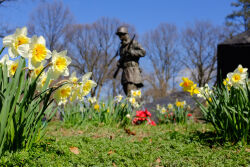Kissena Park
Kissena Grove
The old town of Flushing may claim the rightful title as one of the historic centers of horticulture in the city. In the late 1800s this site, the Kissena Park Historic Grove, was a flourishing nursery founded by Samuel Bowne Parsons (1819-1906). In Parsons’s time, Flushing maintained quite a monopoly on the nursery business. Present-day Flushing reflects the town’s rich horticultural background. You will find rare trees like the weeping beech (Fagus sylvatica) growing in yards and lining streets. Chances are that if you’re walking down the street and see a rare tree along the sidewalk, it has come from Samuel Bowne Parsons’s legendary nursery.
Around 1839, Parsons and Company nursery was established. The Parsons nursery introduced exotic species such as Japanese maples (Acer palmatum) to this continent. Collectors were sent to the Far East and Europe to bring trees and shrubs. Dozens of non-native species now taken for granted in American cities passed through the Parsons nursery before taking root in the country’s soil. Frederick Law Olmsted (1822-1903) who, with Calvert Vaux (1824-1895), designed both Central and Prospect Parks, specially ordered many of the rare trees and plants from Parsons for his ambitiously landscaped parks. Parsons’s son, Samuel Parsons Jr., learned all he knew about horticulture while growing up in the nursery, and went on to become a landscape architect and earned the post of Parks Commissioner in 1905.
Due to a high demand for silk, Parsons imported 25,000 white mulberries (Morus alba). The species was native to Asia and was the preferred food of the silkworm. Since the introduction of the white mulberry to the Parsons nursery at Kissena, this tree has persisted and spread through the eastern and southern United States. Parsons was one of the largest growers of magnolias (Magnolia) and rare evergreens in the country.
When the firm closed, following the elder Parsons’s death in 1906, the City of New York acquired the property for parkland use. At the time, it was the second land acquisition in the gradual formation of Kissena Park. The lake, purchased in 1904, was the first. All but 14 acres of the nursery stock were removed during the initial construction of Kissena Park. It is believed that Parsons himself originated the name “Kissena” for the lake, taking it from the Chippewa Indian word “kissina” meaning “it is cold.” Over the years, the city continued to obtain land and by 1950 had established the Kissena Park boundaries.
This 14-acre plot is now known as the Historic Grove, and consists of mature exotic specimens left over from Parsons’s nursery, such as wisteria (Wisteria) and English ivy (Hedera helix). The Grove is located in the northern part of the park, at Rose Avenue and Parsons Boulevard. The site was rediscovered in 1981 by Parks horticulturist Shelly Stiles and her interns. Their goal was to clean up a two-acre area that had become overgrown. They were surprised to discover the remnants of the old Parsons nursery.
Over 100 varieties of trees can be found at Kissena Grove. The rarest include a Persian parrotia (Parrotica persica) of Iran, Chinese toon (Cedrela sinensis), castor-aralia (Kalopanax pictus) of Japan, China, and Siberia, and Baldcypress trees (Taxodium distichum). One of the most noticeable and interesting trees in the Historic Grove is the katsura (Cercidiphyllum japonicum) of Asia. It may appear to be one tree with many stems shooting from the ground. In fact, these trees were planted in a row as part of the nursery stock, and now have fused together creating the illusion of a single tree.
Check out your park's Vital Signs
Clean & Safe
Green & Resilient
Empowered & Engaged Users
Share your feedback or learn more about how this park is part of a
Vital Park System
Contacts
District Maintenance & Operations Office: (718) 359-1297










